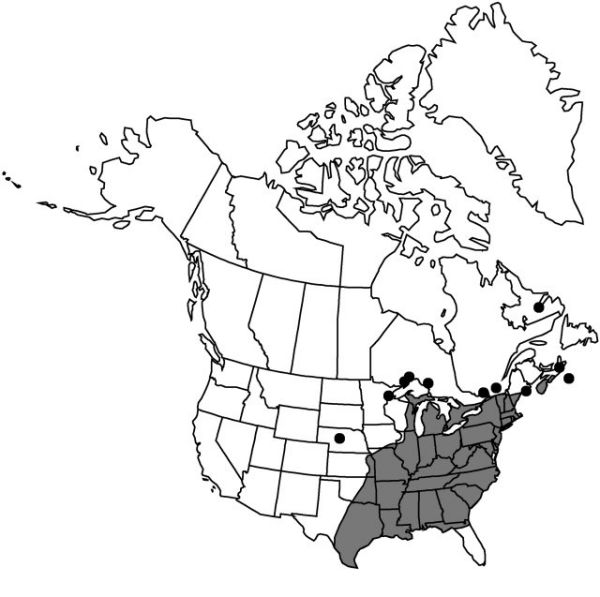Sisyrinchium angustifolium
Gard. Dict. ed. 8, Sisyrinchium no. 2. 1768.
Herbs, perennial, cespitose, dark olive green to bronze or blackish when dry, to 4.5 dm, not glaucous. Stems branched, with 1–2 nodes, 2.3–5 mm wide, glabrous, margins often minutely denticulate especially basally, similar in color and texture to stem body; first internode 10–30 cm, usually longer than leaves; distalmost node with 1–3 branches. Leaf blades glabrous, bases not persistent in fibrous tufts. Inflorescences borne singly; spathes usually green, obviously wider than supporting branch, glabrous, keels denticulate to entire; outer 18–38 mm, 2–9.5 mm longer than inner, usually tapering evenly towards apex, margins basally connate 4–6 mm; inner with keel evenly curved or straight, hyaline margins 0.1–0.3 mm wide, apex acuminate to acute, ending 0.2–0.7 mm proximal to green apex. Flowers: tepals pale blue to violet, occasionally white, bases yellow; outer tepals 7.7–12.5 mm, apex rounded or emarginate, aristate; filaments connate ± entirely, stipitate-glandular basally; ovary similar in color to foliage. Capsules dark brown or black, sometimes with purplish tinge, ± globose, 4–7 mm; pedicel spreading or ascending. Seeds globose to obconic, lacking obvious depression, 0.5–1.2 mm, rugulose. 2n = 96.
Phenology: Flowering spring–early summer.
Habitat: Moist meadows, stream banks, swamp edges, sandy meadows, moist open woods
Elevation: 0–800 m
Distribution

Nfld. and Labr. (Labr.), N.S., Ont., Que., Ala., Ark., Conn., Del., D.C., Fla., Ga., Ill., Ind., Iowa, Kans., Ky., La., Maine, Md., Mass., Mich., Minn., Miss., Mo., Nebr., N.H., N.J., N.Y., N.C., Ohio, Okla., Pa., R.I., S.C., Tenn., Tex., Vt., Va., W.Va., Wis.
Discussion
Sisyrinchium membranaceum E. P. Bicknell probably belongs here; Bicknell indicated that its relationship was “with S. graminoides” and his description falls within that of S. angustifolium, except for slightly shorter spathe bracts.
In previous floras, Sisyrinchium angustifolium often has been confused with S. montanum, especially when S. graminoides was segregated. Branching seems to be the primary point of confusion. The original descriptions of S. angustifolium and S. graminoides clearly indicated branching while that of S. montanum indicates it to be single-stemmed. There is some slight similarity between S. montanum var. crebrum and S. angustifolium with respect to spathe connation and dry color, and chromosome counts indicate that both have 2n = 96, but there is some indication that breeding barriers may exist (D. B. Ward 1959).
Selected References
None.